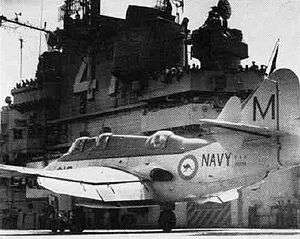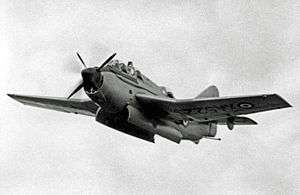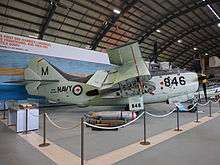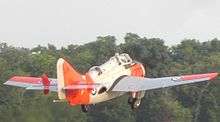Fairey Gannet
| Gannet | |
|---|---|
 | |
| A Royal Navy Fairey Gannet AS.4 | |
| Role | Anti-submarine warfare aircraft |
| National origin | United Kingdom |
| Manufacturer | Fairey Aviation Company |
| Designer | H. E. Chaplin |
| First flight | 19 September 1949 |
| Introduction | 1953 |
| Retired | 15 December 1978[1] |
| Primary users | Royal Navy Royal Australian Navy German Navy Indonesian Navy |
| Produced | 1953–1959 |
| Number built | 303 (Anti-submarine) 45 (Airborne early warning) |
| Variants | Fairey Gannet AEW.3 |
The Fairey Gannet was a British carrier-borne aircraft of the post-Second World War era developed for the Royal Navy's Fleet Air Arm (FAA) by the Fairey Aviation Company. It was a mid-wing monoplane with a tricycle undercarriage and a crew of three, and a double turboprop engine driving two contra-rotating propellers.
The Gannet was originally developed to meet the FAA's dual-role anti-submarine warfare and strike requirement.[2] It was later adapted for operations as an electronic countermeasures and carrier onboard delivery aircraft. The Gannet AEW was a variant of the aircraft developed as a carrier-based airborne early warning platform.
Development
The Gannet was built in response to the 1945 Admiralty requirement GR.17/45, for which prototypes by Fairey (Type Q or Fairey 17, after the requirement) and Blackburn Aircraft (the Blackburn B-54 / B-88) were built.
After considering and discounting the Rolls-Royce Tweed[3] turboprop, Fairey selected an engine based on the Armstrong Siddeley Mamba: the Double Mamba[4] (or "Twin Mamba"), basically two Mambas mounted side-by-side and coupled through a common gearbox to coaxial contra-rotating propellers. Power was transmitted from each engine by a torsion shaft which was engaged through a series of sun, planet, epicyclic and spur gears to give a suitable reduction ratio and correct propeller-shaft rotation.[5]

The ASMD.1 engine (2,950 hp/2,200 kW) was used in the Gannet AS.1; ASMD.3 (3,145 hp/2,345 kW) in the AS.4; and ASMD.4 (3,875 hp/2,889 kW) in the AEW.3 variant. The Double Mamba engine could be run with one Mamba stopped to conserve fuel and extend endurance for cruise flight. The contra-rotating propellers meant that when only half of the Double Mamba was running there were no thrust asymmetry problems.[6] The Mamba exhausts were situated on each side of the fuselage, at the root of the wing trailing edge. The gas-turbine engine could run on kerosene, "wide-cut" turbine fuel or diesel fuel, allowing the Admiralty to eliminate the dangerous high-octane petroleum spirit required to operate piston-engined aircraft from carriers.[6]
In 1958 the Gannet was selected to replace the Douglas Skyraider in the AEW role. In order to accommodate the systems required, the Gannet underwent a significant redesign that saw a new version of the Double Mamba installed, new radome mounted under the aircraft, the tailfin increased in area, the undercarriage lengthened and the weapons bay removed. A total of 44 aircraft (plus a single prototype) of the AEW.3 version were produced.
Design
The pilot was seated well forward, conferring a good view over the nose for carrier operations,[3] and sat over the Double Mamba engine, directly behind the gearbox and propellers. The second crew member, an aerial observer, was seated under a separate canopy directly behind the pilot. After the prototype, a second observer was included, in his own cockpit over the wing trailing edge. This addition disturbed the airflow over the horizontal stabiliser, requiring small finlets on either side.[7] The Gannet had a large internal weapons bay in the fuselage and a retractable radome under the rear fuselage.
The Gannet's wing folded in two places to form a distinctive Z-shape on each side. The first fold was upward, at about a third of the wing span where the inboard anhedral (down-sweep) changed to the outboard dihedral (up-sweep) of the wing (described as an inverted gull wing). The second wing fold was downward, at about two-thirds of the wing span.[8]
The length of the nosewheel shock absorber caused the Gannet to have a distinctive nose-high attitude, a common characteristic of carrier aircraft.
In FAA service, the Gannet generally wore the standard camouflage scheme of a Sky (duck-egg blue) underside and fuselage sides, with Extra Dark Sea Grey upper surfaces, the fuselage demarcation line running from the nose behind the propeller spinner in a straight line to then curve and join the line of the fin. Code numbers were typically painted on the side of the fuselage ahead of the wing; roundel and serial markings were behind the wing. The T.2 and T.5 trainers were finished in silver overall, with a yellow "Trainer band" on rear fuselage and wings.
Operational history
The prototype first flew on 19 September 1949 and made the first deck landing by a turboprop aircraft, on HMS Illustrious on 19 June 1950, by pilot Lieutenant Commander G. Callingham. After a further change in operational requirements, with the addition of a radar and extra crew member, the type entered production in 1953 and initial deliveries were made of the variant designated AS.1 at RNAS Ford in April 1954. A trainer variant (T.2) WN365 first flew in August 1954. The RN's first operational Gannet squadron (826 NAS) was embarked on HMS Eagle. The initial order was for 100 AS.1 aircraft. A total of 348 Gannets were built, of which 44 were the heavily modified AEW.3. Production was shared between Fairey's factories at Hayes, Middlesex and Heaton Chapel, Stockport / Manchester (Ringway) Airport.

By the mid-1960s, the AS.1s and AS.4s had been replaced by the Westland Whirlwind HAS.7 helicopters. Gannets continued as Electronic countermeasures aircraft: the ECM.6. Some AS.4s were converted to COD.4s for Carrier onboard delivery—the aerial supply of mail and light cargo to the fleet.
The Royal Australian Navy purchased the Gannet AS.1 (36 aircraft). It operated from the aircraft carrier HMAS Melbourne and the shore base HMAS Albatross near Nowra, New South Wales.
Indonesia bought a number of AS.4 and T.5s (re-modelled from RN AS.1s and T.2s) in 1959. Some Gannets were later acquired by various other countries.
West Germany bought 15 Gannet AS.4s and one T.5 in 1958. They operated as the anti-submarine squadron of Marinefliegergeschwader 2 (2nd Naval Fighter Wing) from Jagel and Sylt. In 1963 the squadron was reassigned to MFG 3 at Nordholz Naval Airbase until the Gannets were replaced by the Breguet Br.1150 Atlantic in 1966. During its operations the German Navy lost one AS.4, on 12 May 1966, when a Gannet crashed shortly after takeoff from Kaufbeuren, killing all three crew members.
Accidents and mishaps
- 21 November 1958 - Fairey Gannet AS.1, WN345, suffered a belly landing during a test programme, caused by a partially retracted nosewheel. The pilot tried unsuccessfully to get the gear to deploy. He landed gear-up on a foam-covered runway at RAF Bitteswell, suffering minimal damage. After repair, the Gannet was back in the air within weeks.[9]
- 29 July 1959 - Royal Navy Fairey Gannet AS.4, XA465, could not lower the undercarriage, made a power-on deck belly landing into the crash barrier on HMS Centaur. The crew was uninjured but the airframe was written off,[10] salvaged in Singapore, but ending up at the fire dump of Singapore Naval Base.[11]
- 23 January 1964 - Royal Navy Fairey Gannet ECM.6 XG832 suffered double engine failure caused by a phosphor bronze bushing on the idler gear of the port engine’s primary accessory drive failing. Fine metal particles from the gear were carried away by the shared oil system of the two engines, causing both to be destroyed. All three crew bailed out near St Austell and survived.[5]
- 12 May 1966 - German Navy AS.4 UA-115 crashed shortly after takeoff from Kaufbeuren, killing all three crew members. The crash was deemed the result of pilot error.[12]
Harness restraint issues
Tests on the harness restraint system in the Gannet were carried out after a midflight failure due to the release cables binding. The accident itself was the result of an unrelated engine failure, but the primary issue was the failure of the harness quick-release mechanism.
A brief report in Cockpit, Q4 1973, concerning the accident:
"A Gannet was launched at night from Ark Royal and climbed to 4,000 ft. Shortly afterwards the starboard engine ran down to 60%. Attempts to feather and brake the engine, and a subsequent re-light were unsuccessful and the aircraft was unable to maintain height. (It is considered that the most likely cause of the accident was disconnection of the HP cock linkage). Both observers bailed out at 1,800ft, but when the pilot, Lieutenant Keith Jones, tried to bail out he could not free himself from the 'Negative g' strap. However, the rest of the harness had fallen clear and so the pilot was committed to a ditching without any restraint from shoulder or lap straps. This was successfully accomplished and the aircrew were all recovered safely and uninjured...Although the ditching was successful, the most disturbing factor of the accident, was the inability of the pilot to release himself from 'Negative g' strap..."[13]
Variants


| Type | Role | Number Built | Notes |
|---|---|---|---|
| Type Q | Anti-Submarine Warfare | 3 | Three prototypes were ordered, two in August 1946 and one with a rear cockpit mockup was ordered in July 1949. The first VR546 first flew on 19 September 1949 followed by the second VR577 on 6 July 1950. The third WE488 first flew in May 1951 and all three were powered by the Double Mamba ASMD.1. |
| AS.1 | Anti-Submarine Warfare | 183 | |
| T.2 | Dual Control Trainer version of AS.1 | 38 | 1 converted from AS.1 |
| AEW.3 | Airborne Early Warning | 44 | Separate build |
| AS.4 | Anti-Submarine Warfare | 75 | 1 converted from AS.1 |
| COD.4 | Carrier Onboard Delivery | 6 | Converted from AS.4 |
| T.5 | Dual Control Trainer version of AS.4 | 11 | 3 converted from T.2 |
| ECM.6 | Electronic Countermeasures | 9 | Converted from AS.4 Initially classed as AS.6 |
| AEW.7 | Airborne Early Warning | 0 | Proposal for radical upgrade of AEW.3[14] |
Operators
- Marineflieger
- Marinefliegergeschwader 2 (1958–63)
- Marinefliegergeschwader 3 (1963–66)
- Royal Navy Fleet Air Arm
- 700 Naval Air Squadron
- 703 Naval Air Squadron
- 703X Flight
- 719 Naval Air Squadron
- 724 Naval Air Squadron
- 725 Naval Air Squadron
- 737 Naval Air Squadron
- 744 Naval Air Squadron
- 796 Naval Air Squadron
- 810 Naval Air Squadron
- 812 Naval Air Squadron
- 814 Naval Air Squadron
- 815 Naval Air Squadron
- 816 Naval Air Squadron
- 817 Naval Air Squadron
- 820 Naval Air Squadron
- 824 Naval Air Squadron
- 825 Naval Air Squadron
- 826 Naval Air Squadron
- 831 Naval Air Squadron
- 847 Naval Air Squadron
- 849 Naval Air Squadron
- 1840 Naval Air Squadron Royal Naval Volunteer Reserve
Surviving aircraft
Australia

- On display
- Gannet AS.1 XA334, Camden Museum of Aviation, New South Wales[11][15]
- Gannet AS.1 XA331, Queensland Air Museum, Caloundra, Queensland.[11]
- Gannet AS.1 XA434 at the Fleet Air Arm Museum, Nowra, New South Wales
- Gannet AS.1 XG789 the Australian National Aviation Museum, Moorabbin, Victoria.[16]
- Gannet T.5 XG888 at the Fleet Air Arm Museum, Nowra, New South Wales
Germany
- On display

- Gannet AEW.3 XL450, at the Flugausstellung Hermeskeil.[17]
- Gannet AS.4 UA-113, at the Marinefliegermuseum Nordholz e.V
- Gannet AS.4 at Teschionsche Museum Speyer
-AERONAUTICUM -
Indonesia
- On display

- Gannet AS.1, Serial no. F9139 in Surabaya.[18]
- Gannet AS.1, Serial no. F9127 at Satria Mandala Armed Forces Museum in Jakarta.[18]
United Kingdom
- On display
- Gannet T.2 XA508, Midland Air Museum, Coventry[11]
- Gannet T.5 XG883, Museum of Berkshire Aviation, Woodley, Berkshire, England[19]
- Gannet ECM.6 XG831 at Davidstow Airfield and Cornwall at War Museum, Cornwall.[19][20]
- Gannet ECM.6 XA459 at White Waltham Airfield, England[11]
- Gannet ECM.6 XG797 at the Imperial War Museum at Duxford Airfield, Cambridgeshire[19]
- Gannet AEW.3 XL497 at the Dumfries and Galloway Aviation Museum, Scotland
- Gannet AEW.3 XL502 at Yorkshire Air Museum, England[17]
- Gannet AEW.3 XL503 at the Fleet Air Arm Museum, RNAS Yeovilton
- Gannet AEW.3 XP226 at the Newark Air Museum, England[21]
- Under restoration or stored
- Gannet AS.4 XA460 currently under restoration at Aeroventure, Doncaster
- Gannet AEW.3 G-KAEW (XL500) undergoing a full restoration to airworthiness[17]

United States
- Airworthy
- Gannet Prototype XT752 owned by Shannan Hendricks, New Richmond, Wisconsin, the world's last flying T5, returned to flight status 9 August 2013[22][23]
- On display
- Gannet AEW.3 XL482 at Pima Air Museum, Arizona
Specifications (Gannet AS.1)
Data from 'British Naval Aircraft since 1912'[24]
General characteristics
- Crew: 3
- Length: 43ft (13m)
- Wingspan: 54ft 4in (16.56m)
- Height: 13ft 9in (4.19m)
- Wing area: 483 ft² (45 m²)
- Empty weight: 15,069 lb (6,835kg)
- Powerplant: 1 × Armstrong Siddeley Double Mamba ASMD 1 turboprop, 2,950 hp (2,200kW)
- Propellers: 2 contra-rotating 4-bladed
Performance
- Maximum speed: 310 mph (500 km/h)
- Service ceiling: 25,000 ft (7,600 m)
- Endurance: 5-6 hours
Armament
Avionics
See also
- Aircraft of comparable role, configuration and era
- Related lists
References
- Notes
- ↑ 849 Naval Air Squadron flying Gannet COD.4 aircraft from Ark Royal and RAF Lossiemouth
- ↑ Taylor 1974, Pages 356-357.
- 1 2 Williams 1989, p. 94.
- ↑ "British Fighter Aircraft" in Chambers's Encyclopædia. London: George Newnes, 1961, Vol. 1, Plate III.
- 1 2 Gardner, Bob. "Gannet Down! Five Terrifying Minutes." Aeroplane via aeroclocks.com, October 2007. Retrieved: 23 December 2009.
- 1 2 Taylor 1969, p. 361.
- ↑ Williams 1989, p. 95.
- ↑ "Two Novel Warplanes Produced in Britain." Popular Mechanics, February 1955, p. 109.
- ↑ Willis 2006, pp. 43–44.
- ↑ Smith 2008, p. 42.
- 1 2 3 4 5 "UK Military Aircraft Serial Allocations: XA". UK Serials Resource Centre. Retrieved 1 April 2011.
- ↑ " Marineflieger-geschwader 3." fly-navy.de. Retrieved: 23 December 2009.
- ↑ "Accident Briefs reports". Cockpit, Issue 65, Fourth Quarter 1973.
- ↑ Gibson, Chris. The Admiralty and AEW. Project Tech Profiles, 2011, ISBN 0-9561951-2-1. p. 22.
- ↑ "Gannet A.S. Mk 1 XA334." camdenmuseumofaviation.com.au. Retrieved: 23 December 2009.
- ↑ Australian National Aviation Museum - Fairey Gannet A.S.4 - XG789 Retrieved September 10, 2016
- 1 2 3 "UK Military Aircraft Serial Allocations: XL". UK Serials Resource Centre. Retrieved 4 April 2011.
- 1 2 "Fairey Gannet." airliners.net. Retrieved: 23 December 2009.
- 1 2 3 "UK Military Aircraft Serial Allocations: XG". UK Serials Resource Centre. Retrieved 4 April 2011.
- ↑ Cornwall at War Museum
- ↑ "Newark Air Museum Aircraft List". Newark Air Museum. Retrieved 6 October 2014.
- ↑ "UK Military Aircraft Serial Allocations: XT". UK Serials Resource Centre. Retrieved 4 April 2011.
- ↑ Hendricks, Shannon. "XT752: The world's last flying Fairey Gannet T5." faireygannetxt752.com. Retrieved: 1 December 2010.
- Bibliography
- Smith, Dave. "Hit The Deck." Flypast, No. 328, November 2008.
- Sturtivant, Ray and Theo Ballance. The Squadrons of the Fleet Air Arm. London: Air-Britain, 1994. ISBN 0-85130-223-8.
- Taylor, H.A. Fairey Aircraft Since 1915. London: Putnam, 1974. ISBN 0-370-00065-X.
- Taylor, John W.R. "Fairey Gannet". Combat Aircraft of the World from 1909 to the Present. New York: G.P. Putnam's Sons, 1969 (reprinted 1977). ISBN 0-425-03633-2, ISBN 978-0-425-03633-4.
- Thetford, Owen. British Naval Aircraft Since 1912. London: Putnam, 1978. ISBN 0-370-30021-1.
- Velek, Martin, Michal Ovčáčík and Karel Susa. Fairey Gannet Anti-submarine and Strike Variants, AS Mk.1 & AS Mk.4 . Prague, Czech Republic: 4+ Publications, 2007. ISBN 978-80-86637-04-4.
- Williams, Ray. Fly Navy: Aircraft of the Fleet Air Arm Since 1945. London: Airlife Publishing, 1989. ISBN 1-85310-057-9.
- Willis, David. "Fairey's Versatile Gannet - Part Two", Air Enthusiast, Number 124, July–August 2006.
External links
| Wikimedia Commons has media related to Fairey Gannet. |